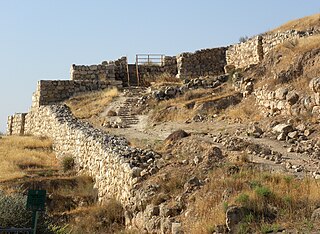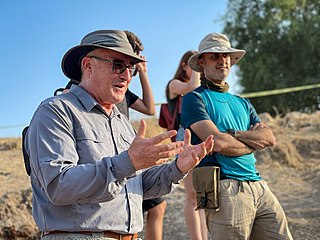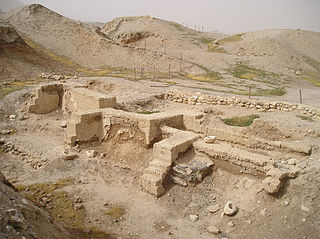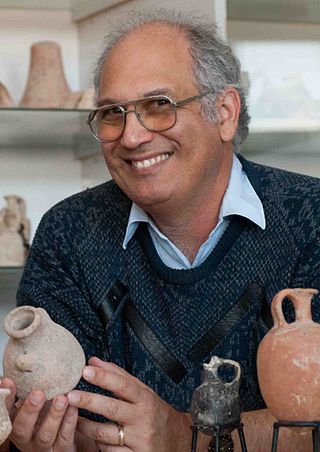Related Research Articles

The Levant is an approximate historical geographical term referring to a large area in the Eastern Mediterranean region of West Asia and core territory of the political term Middle East. In its narrowest sense, which is in use today in archaeology and other cultural contexts, it is equivalent to Cyprus and a stretch of land bordering the Mediterranean Sea in western Asia: i.e. the historical region of Syria, which includes present-day Israel, Jordan, Lebanon, Syria, the Palestinian territories and most of Turkey southwest of the middle Euphrates. Its overwhelming characteristic is that it represents the land bridge between Africa and Eurasia. In its widest historical sense, the Levant included all of the Eastern Mediterranean with its islands; that is, it included all of the countries along the Eastern Mediterranean shores, extending from Greece in Southern Europe to Cyrenaica, Eastern Libya in Northern Africa.

The Philistines were an ancient people who lived on the south coast of Canaan during the Iron Age in a confederation of city-states generally referred to as Philistia.

Canaan was a Semitic-speaking civilization and region of the Southern Levant in the Ancient Near East during the late 2nd millennium BC. Canaan had significant geopolitical importance in the Late Bronze Age Amarna Period as the area where the spheres of interest of the Egyptian, Hittite, Mitanni, and Assyrian Empires converged or overlapped. Much of present-day knowledge about Canaan stems from archaeological excavation in this area at sites such as Tel Hazor, Tel Megiddo, En Esur, and Gezer.

Philistia was a confederation of five main cities or pentapolis in the Southwest Levant, made up of principally Gaza, Ashkelon, Ashdod, Ekron, and Gath, and for a time, Jaffa.

Lachish was an ancient Israelite city in the Shephelah region of Canaan on the south bank of the Lakhish River mentioned several times in the Hebrew Bible. The current tell by that name, known as Tel Lachish or Tell el-Duweir, has been identified with Lachish. Today, it is an Israeli national park operated and maintained by the Israel Nature and Parks Authority. It lies near the present-day moshav of Lakhish.

The Southern Levant is a geographical region encompassing the southern half of the Levant. It corresponds approximately to modern-day Israel, Palestine, and Jordan; some definitions also include southern Lebanon, southern Syria and/or the Sinai Peninsula. As a strictly geographical description, it is sometimes used by archaeologists and historians to avoid the religious and political connotations of other names for the area.

Tel Megiddo, called in Arabic Tell el-Mütesellim "tell of the Governor", is the site of the ancient city of Megiddo, the remains of which form a tell or archaeological mound, situated in northern Israel at the western edge of the Jezreel Valley about 30 kilometres (19 mi) southeast of Haifa near the depopulated Palestinian town of Lajjun and subsequently Kibbutz Megiddo. Megiddo is known for its historical, geographical, and theological importance, especially under its Greek name Armageddon. During the Bronze Age, Megiddo was an important Canaanite city-state. During the Iron Age, it was a royal city in the Kingdom of Israel.

Israel Finkelstein is an Israeli archaeologist, professor emeritus at Tel Aviv University and the head of the School of Archaeology and Maritime Cultures at the University of Haifa. Finkelstein is active in the archaeology of the Levant and is an applicant of archaeological data in reconstructing biblical history. Finkelstein is the current excavator of Megiddo, a key site for the study of the Bronze and Iron Ages in the Levant.

Tel Arad or Tell 'Arad is an archaeological tell, or mound, located west of the Dead Sea, about 10 kilometres west of the modern Israeli city of Arad in an area surrounded by mountain ridges which is known as the Arad Plain.

The Kingdom of Aram-Damascus was an Aramean polity that existed from the late-12th century BCE until 732 BCE, and was centred around the city of Damascus in the Southern Levant. Alongside various tribal lands, it was bounded in its later years by the polities of Assyria to the north, Ammon to the south, and Israel to the west.

The Late Bronze Age collapse was a time of widespread societal collapse during the 12th century BC associated with environmental change, mass migration, and the destruction of cities. The collapse affected a large area of the Eastern Mediterranean and the Near East, in particular Egypt, eastern Libya, the Balkans, the Aegean, Anatolia, and, to a lesser degree, the Caucasus. It was sudden, violent, and culturally disruptive for many Bronze Age civilizations, and it brought a sharp economic decline to regional powers, notably ushering in the Greek Dark Ages.

Aren Maeir is an American-born Israeli archaeologist and professor in the Department of Land of Israel Studies and Archaeology at Bar-Ilan University. He is director of the Tell es-Safi/Gath Archaeological Project.
Facts on the Ground: Archaeological Practice and Territorial Self-Fashioning in Israeli Society is a 2001 book by Nadia Abu El Haj based on her doctoral thesis at Duke University. The book has been praised by some scholars and criticised by others.

Levantine archaeology is the archaeological study of the Levant. It is also known as Syro-Palestinian archaeology or Palestinian archaeology. Besides its importance to the discipline of Biblical archaeology, the Levant is highly important when forming an understanding of the history of the earliest peoples of the Stone Age.

Avraham Biran was an Israeli archaeologist, best known for heading excavations at Tel Dan in northern Israel. He headed the Institute of Archaeology at Hebrew Union College in Jerusalem for many years.

Prof. Christopher A. Rollston is a scholar of the ancient Near East, specializing in Hebrew Bible, Greek New Testament, Old Testament Apocrypha, Northwest Semitic literature, epigraphy and paleography.

Steven A Rosen is the Canada Chair in Near Eastern Archaeology in the Archaeological Division of the Department of Bible, Archaeology and Ancient Near East at Ben-Gurion University of the Negev. He serves as the Vice President for External Affairs. His research has focused on two general areas, the continued use of chipped stone tools in the periods during which metals were already exploited, and the archaeology of mobile pastoralists, using the Negev as an in-depth case study.

Oded Lipschits is an Israeli professor in the Department of Archaeology and Ancient Near East Studies at Tel Aviv University. In 1997 he earned his Ph.D. in Jewish History under the supervision of Nadav Na'aman. He has since become a Senior Lecturer and Full Professor at Tel Aviv University and served as the Director of the Tel Aviv Institute of Archaeology since 2011. Lipschits is an incumbent of the Austria Chair of the Archeology of the Land of Israel in the Biblical Period and is the Head and founder of the Ancient Israel Studies Masters program in the Department of Archaeology and Ancient Near East Studies.
Matthew J. Adams is an archaeologist who specializes in the Near East. He earned his degrees at Pennsylvania State University and the University of California, Los Angeles. He served as the director of the Albright Institute of Archaeological Research in Jerusalem (2014–2022), and is the current president of American Archaeology Abroad, Inc. He has worked on several archaeological projects in the past, and is currently director of the Jezreel Valley Regional Project, Co-Director of the Megiddo Expedition along with Israel Finkelstein and Mario Martin, and co-director of the Solomon's Pools Archaeological Project with Mark Letteney.
Michael Mathias Homan was a Professor of Theology and Department Head at Xavier University of Louisiana in New Orleans. He attended the University of Nebraska Omaha, and the University of California San Diego where he majored in Hebrew Bible and minored in Near Eastern Archaeology and Ancient Near Eastern History and Religion. Homan taught courses in Hebrew Bible, Hebrew language, ancient Near Eastern religion, and a course about the cemeteries of New Orleans.
References
- ↑ Vergano, Dan (26 November 2003). "James ossuary opens a Pandora's box of suspected fakes; Objects, authentication are called into question". USA Today .
- 1 2 3 "WEDDINGS; Rachel Hallote, Alexander Joffe". The New York Times . October 26, 1992.
- ↑ Jewish National Fund Speakers Bureau Archived December 31, 2010, at the Wayback Machine
- ↑ "Judaic studies scholar Alexander Joffe Speaking at University". Knoxville News Sentinel . 13 March 2004.
- ↑ "Videos & Podcasts". American Schools of Oriental Research. Retrieved 8 November 2016.
- ↑ Grabbe, Lester L. (2007). Ancient Israel: What Do We Know and How Do We Know It?. A. & C. Black. p. 110. ISBN 978-0567032546.
- ↑ "Failed Religious Diplomacy at the Birth of Israel". The National Interest. 31 March 2014. Retrieved 22 May 2015.